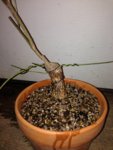John in Toledo
Mame
My office neighbor here in downtown Toledo asked me to collect all his shubbery (A Euonymous - I think it's a dwarf of alatus but, I'm not sure - and three boxwoods). This may belong in several threads, so forgive me if this is a forum faux pas. Anyone got good beginner advice for helping the Euonymous settle in well, and live happily? I've been noticing them here for three years or so since I arrived from Florida, and the striking fall colors were too enticing to pass up once the offer was made. I collected it following a good rain, during a random winter warm spell. (Base is perhaps 1.5-2 inches in diameter). I didn't mess with the roots much and potted it in the soil it was collected with. I figure it was happy there, so why mess with it while the tree is getting used to the potted life. I trimmed branches back to about 30 inches above the ground, trying to leave a lot of growth nodes. It's mostly been garage kept for the last three weeks or so. I think I should probably protect it until the Ohio nights get a bit reliably warmer.
Any advice for giving this baby the best chance at happiness?
Any advice for giving this baby the best chance at happiness?





